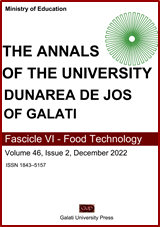Physical, barrier, and thermal properties characterization of edible films from composite mixtures of starch and starch derivatives
Abstract
In the search for sustainable and ecological alternatives in food packaging, the use of starch as one of the most abundant biopolymer resources to formulate edible films has been studied. Nonetheless, compatibility with other starch derivatives, such as dextrin and/or chemically modified starch, has not been explored yet. The objective of this research was to characterize opacity, water vapor barrier capability, and thermal properties of composite edible films, by a mixture design approach, formulated with three types of commercial chemical modified starch mixed with native corn starch and dextrin. Lower opacity in edible films was related to more soluble material, where the main effect of dextrin was the rise of soluble material and lower water vapor permeability. A more permeable film can be obtained with Nifrastarch and lower permeability with Gelamil. The type of chemically modified starch used in edible films for edible packaging can be decided according to the characteristics of the food in question, i.e., moisture, color, permeability, or edible film solubility for active packaging.


